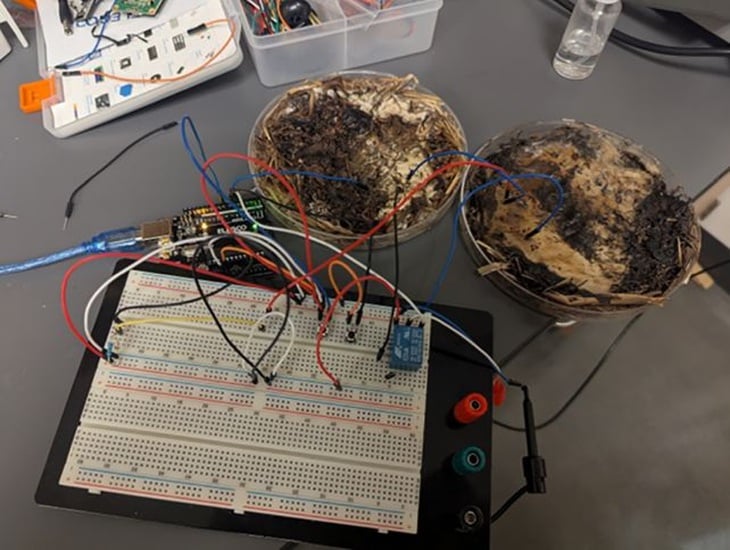
The "mushroom memristor resistors" are connected to an electrical circuit - Photo: PLOS ONE
Scientists have used shiitake mushrooms (scientific name Lentinula edodes ) to make memristors (electrical components that store information in resistors) not from titanium dioxide or silicone but from the root-like part of the mushroom, called the mycelium.
As a result, the team created a memory resistor with performance comparable to a silicon chip, but is low-cost and environmentally friendly in a way that many current computer components are not, according to ScienceAlert on October 28.
The team considered using mushrooms as computer components in part because fungal mycelium networks function similarly to neural networks. They have a similar structure and transmit information using electrical and chemical signals, just like the human brain.
The team chose shiitake mushrooms because they are hardy, have elastic mycelium, and are resistant to stressors such as radiation.
After culturing them in the lab, the team exposed nine petri dishes containing the fungi to direct sunlight in a well-ventilated area to ensure their long-term viability.
They then connected each mushroom sample to a specialized electrical circuit. "We connected the wires and probes at different times on the mushroom because different parts of the mushroom have different electrical properties. Depending on the voltage and connection, we recorded different performances," said John LaRocco, a psychiatrist at Ohio State University.
The team achieved 5,850Hz performance, with 90% accuracy, from their “mushroom memristor.” This means the memristor can switch signals at a rate of about 5,850 times per second. The slowest memristor on the market today is almost double that, showing that the research is extremely promising from the very beginning.
Computers powered by mycelium won’t be available on the market anytime soon, but the discovery suggests a promising direction for future research and development toward low-cost, accessible, and biodegradable components.
The research could also have potential applications ranging from personal devices to the aerospace industry. “The future of computing may be mushrooms,” the team writes in the study, published in the journal PLOS One .
Source: https://tuoitre.vn/che-tao-bo-nho-may-tinh-tu-nam-20251028120959772.htm


![[Photo] Draft documents of the 14th Party Congress reach people at the Commune Cultural Post Offices](https://vphoto.vietnam.vn/thumb/1200x675/vietnam/resource/IMAGE/2025/10/28/1761642182616_du-thao-tai-tinh-hung-yen-4070-5235-jpg.webp)

![[Photo] National Assembly Chairman Tran Thanh Man received a delegation of the Social Democratic Party of Germany](https://vphoto.vietnam.vn/thumb/1200x675/vietnam/resource/IMAGE/2025/10/28/1761652150406_ndo_br_cover-3345-jpg.webp)


![[Photo] Flooding on the right side of the gate, entrance to Hue Citadel](https://vphoto.vietnam.vn/thumb/1200x675/vietnam/resource/IMAGE/2025/10/28/1761660788143_ndo_br_gen-h-z7165069467254-74c71c36d0cb396744b678cec80552f0-2-jpg.webp)





























![[Photo] President Luong Cuong attends the 80th Anniversary of the Traditional Day of the Armed Forces of Military Region 3](https://vphoto.vietnam.vn/thumb/1200x675/vietnam/resource/IMAGE/2025/10/28/1761635584312_ndo_br_1-jpg.webp)









































































Comment (0)